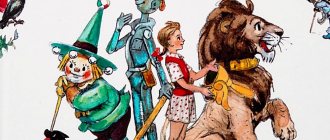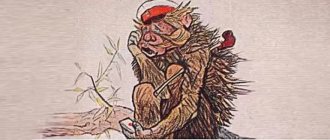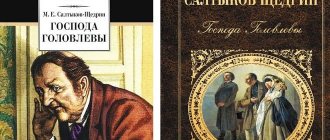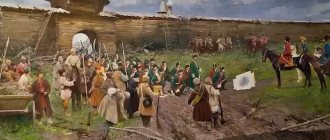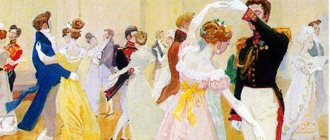The satire in Saltykov-Shchedrin's novel “The History of a City” (1870) has caused a lot of negative criticism since its publication. The work allegorically depicts Russian history of the second sex. XVIII – beginning XIX centuries The writer was accused of distorting historical facts and mocking the Russian people. And for good reason.
The Russian people, their ancestors, historical figures are mockingly ridiculed. The writer’s satirical talent gave birth to a Russophobic masterpiece, from which similar exercises on a Russian theme later grew.
The history of the creation of “The Story of a City”
The idea of the work was nurtured by the author for several years. In 1867, a story appears about a mayor with a stuffed head, eaten with gusto at the end. This hero transformed into a governor named Pyshch. And the story itself became one of the chapters of the story.
Mikhail Evgrafovich Saltykov-Shchedrin (1826-1889)
A year later, the author began writing Foolov's chronicle itself. The work lasted more than a year. Initially, the work was called “The Foolov Chronicler”; the final title appeared later. The name change is due to the fact that the second carries a broader meaning.
In the year of graduation, the story was first published in the anthology “Notes of the Fatherland,” where Mikhail Evgrafovich signed the pseudonym N. Shchedrin. An independent publication comes out in six months. The text is slightly different. The sequence of chapters has been changed, and the characteristics and descriptions of the governors have been rewritten in abbreviation, but have become more expressive.
The era of retirement from wars
After Wartkin, Negodyaev, who was the same destroyer, came to power. According to the chronicler, he was overthrown from power because of his very democratic views, as well as the same intentions. The city was very weak after a series of wars and riots, so it simply could not survive another war.
Then Mikaladze became the ruler. For him, the word “constitution” was an unknown word, therefore, as the commander-in-chief of the Foolovites, he was ideal. His rule had absolutely no effect. He was of little interest in the affairs of the Foolovites and the life of the city; women were of much greater interest to him.
After Mikaladze, Feofilakt Irinarkhovich became the ruler of the Foolovites. This ruler loved laws very much and constantly wrote them. At night, secretly from everyone, he came up with a new law, which in the morning already “delighted” the citizens. But soon they learned about his activities and immediately removed the mayor from his place. Because of his active work, he was even suspected of colluding with Napoleon.
Next, Pimple came to the board. He, too, was not without peculiarities. He had a stuffed head. Residents began to suspect that something was wrong after they began harvesting huge crops for a long time. However, no action was taken to this end. The city began to live in abundance. But at one moment the leader of the nobility heard the smell of truffles coming from the head of the commander-in-chief. After which he was attacked and his head was eaten.
The main characters and their characteristics
The main characters of the work are the mayors and townspeople - the inhabitants of Foolov. Below is a table with characteristics. A brief overview of the main characters is given.
| Amadeus Manuilovich Klementy | Italian. At home he served as a cook. His signature and most delicious dish was pasta. The Duke of Courland, admired by his culinary skills, took him with him as the family cook. After Amadeus Manuilovich received a high status, which helped him take the position of mayor. Clementy forced all the Foolovites to make pasta. Sent into exile for high treason. |
| Fotiy Petrovich Ferapontov | He was the personal hairdresser of the Duke of Courland. After which he began to manage the city. A big fan of spectacles. I never missed public punishments in the square. Always present when someone was flogged. In 1738, the manager was torn to pieces by dogs. |
| Ivan Matveevich Velikanov | He is famous for drowning the director responsible for economics and management in a reservoir. For the first time he introduced a tax on citizens. From each, a few kopecks go into the board’s treasury. He often beat police officers most severely. Spotted in an indecent relationship with the first wife of Peter I (Avdotya Lopukhina). After which he was taken into custody, where he remains to this day. |
| Manyl Samylovich Urus-Kugush-Kildibaev | Brave military man, guardsman. Management methods are appropriate. The townspeople remembered him for his courage, bordering on madness. Once Foolov even took the city by storm. There is little information about him in the chronicle. But it is known that in 1745 he was dismissed from the post of governor. |
| Lamvrokakis | Fugitive Greek citizen of unknown origin, name and family. Before becoming a mayor, he sold soap, oils, nuts and other small items at the market of a neighboring city. He died in his own bed in an unequal battle with bedbugs. |
| Ivan Matveevich Baklan | Famous for his tall height of more than two meters. Killed during a hurricane. A strong wind broke the man in half. |
| Dementy Varlamovich Brudasty | The role of the brain in his head was performed by a peculiar mechanism resembling an organ. But this did not interfere with the performance of the duties of the governor, the preparation and execution of papers. That's why the residents affectionately called him Organchik. He had no contact with the public, but constantly uttered a single menacing phrase: “I will not tolerate it!” Why were the city dwellers in constant fear? He actively collected taxes and taxes. After his reign there was anarchy for about a week. The image symbolizes the stupidity, emptiness and limitations of the majority of officials and managers. |
| Semyon Konstantinovich Dvoekurov | Active and active manager. Paved roads (two of them). Organized local production of beer and honey drinks. Forced residents to grow and consume mustard and bay leaves. He collected arrears more actively than others. For any offenses and without them, the Foolovites were flogged with rods. The only one who died of natural causes. |
| Petr Petrovich Ferdyshchenko | Former soldier. He was Potemkin's orderly, of which he was quite proud. The first six years passed quietly. But then the foreman seemed to go crazy. He was not distinguished by the depth of his mind. He had a speech impediment and was therefore tongue-tied. Died from overeating. |
| Vasilisk Semenovich Wartkin | Appears in the chapter "Wars for Enlightenment". The hero's portrait corresponds to his surname. The longest reign in the city's history. His predecessors started arrears, so Wartkin took it strictly. In the process, more than 30 villages burned down, and only two and a half rubles were saved. He arranged one square and planted trees on one street. Constantly buttoned up, put out fires, created false alarms. Solved problems that didn't exist. He forced the Foolovites to build houses on foundations, plant Persian chamomile, and use Provençal oil. He dreamed of annexing Byzantium, and then renaming Constantinople to Ekaterinograd. I tried to open an academy, but it didn’t work. That's why he built a prison. He fought for enlightenment, but at the same time against it. True, the inhabitants of the city did not see the difference. He could have done a lot more “useful” things, but he suddenly died. |
| Onufriy Ivanovich Negodyaev | A man of the people. He served as a stoker in Gatchina. He ordered the destruction of the streets paved by his predecessors. And from the resulting stone, build monuments and landmarks. Foolov fell into decay, there was devastation all around, and the townspeople became wild, even overgrown with wool. He was dismissed from his position. |
| Gloomy-Burcheev | In the past he was a military man, so he is obsessed with the army and military operations. Empty, limited, stupid, like most of the characters in the book. He preferred to destroy Foolov and rebuild another city nearby, making it a military fortification. Forced residents to wear military uniforms, live according to army regulations, follow absurd orders, line up and march. Ugryumov always slept on the bare ground. He went missing during a natural phenomenon that no one could explain. |
| Erast Andreevich Grustilov | He always looked offended and upset, which did not stop him from being depraved and vulgar. During his reign, the city was mired in debauchery. He wrote melancholic odes. He died of inexplicable melancholy. |
| Acne | Like many of the city's rulers, they are former military men. He was in office for several years. I decided to take up management to take a break from work. The Foolovites suddenly became rich under him, which aroused suspicion and unhealthy reactions among the masses. It later turned out that the governor had a stuffed head. The ending is deplorable and unpleasant: the head was eaten. |
Mayors of Foolov
With the help of the rulers, the author wanted to show the absurdity of the actions of these people. He deliberately changed the names of the mayors, making them funny.
From the stories of the chroniclers, only 21 rulers were recorded. But the inventory indicated a list of 22 people. Apparently, the prince himself did not enter it. The main rulers of the city:
- Giants. He became famous for drowning the director of economic affairs and introducing taxes of 3 kopecks per person. He was sent to prison for a forbidden affair with the first wife of Peter I.
- Cormorant. This man was proud of his family connection with Ivan the Terrible.
- Pfeiffer. "Holstein native." He was removed from his post for ignorance.
- Acne. Major, a fairly wealthy man. He gave complete freedom to the townspeople.
- Brudasty or “Organchik”, as he was nicknamed for having a device in his head. This ruler kept the Foolov at bay. He was a sullen and withdrawn person. After his departure, chaos began in the city, which lasted a whole week.
- Two-spirited. A period of well-being for citizens is associated with this mayor. He was engaged in the external arrangement of the city. He organized beer and mead making and tried to open an academy.
- Wartkin ruled for a very long time. He can be compared to Peter I. They had similar styles of government. The mayor destroyed 2 settlements (Streletskaya and Navoznaya), fought 4 wars for enlightenment, and then 3 against it. He prepared the townspeople for burning, but died.
- Scoundrels destroyed the streets that were laid by the previous mayor and erected monuments there. He was fired due to disagreement with changes to the constitution.
- Grustilov occupied the local residents with balls and nightly meetings, where he read the works of some gentleman. He was indifferent to the people, even though the people were starving and poor.
- Burcheev destroyed the city and decided to build Nepreklonsk. But the “end of the world” happened: the sun became dark, the earth began to shake, and the ruler himself disappeared. This is how the history of the city ended.
Minor characters
| Prince | A foreign ruler whom the Foolovites asked to become their prince. He was stupid, but cruel. All questions were resolved with the exclamation: “I’ll screw it up!” |
| Iraida Lukinichna Paleologova | An impostor who appeared during the period of unrest after the death of Brudasty (Organchik). Based on the fact that her husband reigned for several days, and her historical surname (an allusion to Sophia Paleologus, the grandmother of Ivan the Terrible), she demanded power. Rules for a few days outside the city. |
| Intercept-Zalikhvatsky | He appeared victoriously on a white horse. He burned down the gymnasium. Zalikhvatsky became the prototype of Paul I. |
| Foolovites | Residents of the city. A collective image of a people blindly worshiping the tyranny of power. |
The list of heroes is not complete, it is given in abbreviation. During the time of unrest alone, more than ten rulers were replaced, six of them women.
It is a summary of the work in chapters.
The plot of the work
The narration is told on behalf of the chronicler. He talks about the inhabitants of the city who were so stupid that their city was given the name “Fools”. The novel begins with the chapter “On the Roots of the Origin of the Foolovites,” which gives the history of this people. It tells in particular about a tribe of bunglers, who, after defeating the neighboring tribes of bow-eaters, bush-eaters, walrus-eaters, cross-bellied people and others, decided to find a ruler for themselves, because they wanted to restore order in the tribe. Only one prince decided to rule, and even he sent an innovative thief in his place. When he was stealing, the prince sent him a noose, but the thief was able to somehow get out of it and stabbed himself with a cucumber. As you can see, irony and grotesque coexist perfectly in the work.
After several unsuccessful candidates for the role of deputies, the prince came to the city in person. Having become the first ruler, he started the countdown of the “historical time” of the city. It is said that twenty-two rulers with their achievements ruled the city, but the Inventory lists twenty-one. Apparently, the missing one is the founder of the city.
From the publisher
The abstract says that the author has long wanted to tell the history of a place. And I found in the archive a chronicle of this locality, which was alternately created by several archivists. It formed the basis of the work.
The narrator assures the reader of the document's authenticity. To prove the absence of artistic fiction, an argument is made about the monotony of the narrative. The text is entirely devoted to the biographies of mayors and the peculiarities of their reign.
The story begins with the address of the last clerk, who outlined the chronicle of events.
About the root of the origin of fools
The chapter describes the prehistoric period. The tribe of bunglers waged internecine wars with their neighbors, defeating them. When the last enemy was defeated, the population was confused. Then they began the search for a prince to rule them. But even the stupidest princes did not want to take power over the savages.
They found someone who agreed to “volody”, but did not go to live on the territory of the property. He sent governors who turned out to be thieves. I had to appear to the prince in person.
Worship of Mammon and repentance
The successor to the stuffed head, State Councilor Ivanov, died from a decree that he could not understand and burst from mental strain.
The Viscount de Chariot came to replace him. Life under him was fun, but stupid. No one was involved in administrative matters, but there were many holidays, balls, masquerades, and other fun.
Analysis of the work
The work cannot belong to small literary forms: a story or a fairy tale. In terms of content, composition and depth of meaning, it is much broader.
The author himself defined the genre of “Stories of a City” as a satirical novel. And it represents a chronological overview of the life of this area. So the reader experiences dissonance of perception.
Townspeople and their features
The genre of “Stories of a City” is a satirical story. It exposes the morals and relationships between rulers and people in an autocratic society. The writer had been nurturing the idea of creating a work for a long time. He began writing in 1867, and finished in 1870. The first name of the comedy was “The Foolish Chronicler,” but then it was renamed.
The main characters of the work are Foolovites and mayors . In the characteristics of the heroes of “The Story of a City” one can guess the mentality of the Russian people. Each character is different from the other, which amazes you from the first pages of the book.
The story begins with a description of how a tribe of bunglers defeated neighboring communities and tribes. They decided to find a ruler for themselves in order to restore order in their society, and went to the princes, but they refused this position. However, there was a person who agreed to this. In desperation, the tribe turned to the innovative thief, who helped them find a suitable candidate. The prince decided that he would rule these people, but refused to live with them. He sent a thief in his place.
They decided to rename the Golovotyaps as Foolovites, since people were stupid. It was easy to control them ; they unquestioningly carried out their duties and any orders . Novotor did not like this, since he wanted to see them as rebellious residents in order to pacify them. Once Novotor was caught stealing, for which the prince ordered him to be hanged. But the thief managed to get out of this situation - he stabbed himself with a cucumber. In this plot, irony is intertwined with the grotesque.
The prince sent new rulers, but each subsequent one turned out to be worse than the previous one. Then he had to come to the city in person. This marked the beginning of the countdown of the city’s “historical time.”
In the person of the city residents, the satirist shows a collective image of ordinary Russian people. They are so stupid that there are legends about it. Nobody wants to manage them. When the residents managed to find the city governor, they began to understand their stupidity, but this caused them even more suffering.
The image of society is revealed in all chapters of the work. The author's irony is constantly increasing. Residents of Foolov are happy to have any ruler; they need a “master”. At the same time, Foolovites do not pay attention to the traits of city rulers. They are indifferent to internal and external content. Residents are ready to carry out even strange orders, for example, to cook only pasta for everyone, wear dresses, and eat frogs. The Foolovite crowd has the following characteristics:
- impermanence;
- stupidity;
- respect for established authority;
- feeling of defenselessness.
Any new ruler tried to impose his rules, habits and foundations on them. A quote characterizing the Foolovites: “Idiots are generally very dangerous, and not even because they are necessarily evil... they are alien to all considerations and always go ahead, as if the road on which they find themselves belongs exclusively to them.”
Conclusion
The history of the state is reflected from the time of Rurik's calling to the principality and feudal fragmentation. The appearance of two False Dmitrys, the reign of Ivan the Terrible and the turmoil after his death are covered. He appears in the form of Brudasty. Dvoekurov, who becomes an activist and innovator, establishing brewing and mead making, symbolizes Peter I with his reforms.
The Foolovites unconsciously worship autocrats and tyrants, carrying out the most absurd orders. Residents are the image of the Russian people.
The satirical chronicle could be applied to any city. The work ironically conveys the fate of Russia. The story does not lose its relevance to this day. A film was made based on the work.
